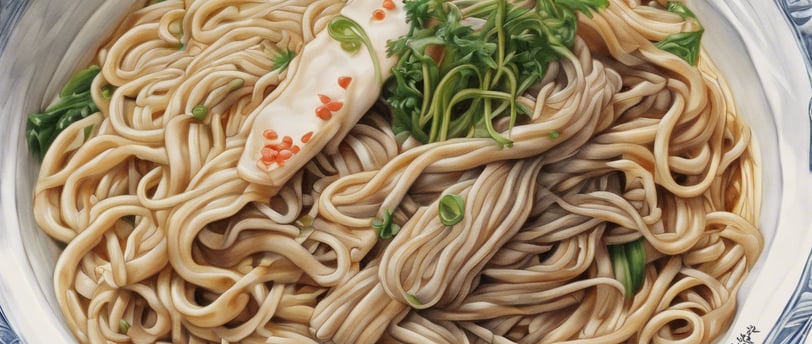The History and Culture of Chinese Noodles: Evolution from Ancient Times to Today
Chinese noodles, a staple in Chinese cuisine, have a rich history that spans over four millennia. As one of the most beloved foods in China, noodles are not just a source of sustenance but a symbol of culture, tradition, and even spirituality. The journey of Chinese noodles from ancient times to today reflects the evolution of Chinese society, its technological advancements, and its cultural exchanges with the world.
Ancient Beginnings
The earliest evidence of noodles in China dates back to the Han Dynasty (206 BCE – 220 CE). Archaeological discoveries suggest that noodles were made from millet, a staple grain before wheat became widespread in China. A significant find in 2002 unearthed a 4,000-year-old bowl of noodles at the Lajia archaeological site, which pushed back the timeline of noodle consumption significantly. These ancient noodles were made from millet, and their discovery highlighted the ingenuity of early Chinese culinary techniques.
Evolution During the Dynasties
As China progressed through various dynasties, the art of noodle-making evolved significantly. During the Tang Dynasty , wheat became the predominant grain, leading to the widespread production of wheat noodles. This period saw the development of various noodle shapes and cooking methods, including boiling, steaming, and frying.
The Song Dynasty (960-1279 CE) was a golden age for Chinese noodles. Urbanization and the flourishing economy led to the rise of noodle shops and stalls, making noodles a popular and accessible food for people from all walks of life. The Song era also brought innovation in noodle types, such as hand-pulled noodles and knife-cut noodles.
Regional Varieties and Cultural Significance
China’s vast geography and diverse cultures have given rise to an incredible variety of noodles, each with unique characteristics and preparation methods. Here are some notable regional varieties:
Beijing and Northern China: The colder climate favors wheat over rice, leading to the popularity of wheat-based noodles like Zhajiangmian a hearty dish topped with minced pork and fermented soybean paste.
Sichuan: Known for its bold and spicy flavors, Sichuan cuisine offers Dan Dan Noodles , featuring a spicy, numbing sauce made from Sichuan peppercorns and chili oil.
Shaanxi: Home to Biang Biang noodles , these thick, wide noodles are often served with a spicy, vinegary sauce and are renowned for their chewy texture.
Southern China: In regions like Guangdong, rice noodles are more prevalent. Wonton noodles are a beloved dish, featuring thin egg noodles and delicate wontons in a savory broth.
Noodles also hold cultural significance in various Chinese traditions and celebrations. For example, long noodles are eaten during birthdays and the Lunar New Year as a symbol of longevity and good fortune. The length of the noodles represents a long life, and cutting them is considered bad luck.
Technological Advancements and Modern Innovations
The Industrial Revolution and advances in technology brought significant changes to noodle production. The invention of mechanized noodle-making machines in the late 19th and early 20th centuries revolutionized the industry, making noodles more affordable and accessible.
In the modern era, instant noodles, invented by Taiwanese-Japanese entrepreneur Momofuku Ando in 1958, have become a global phenomenon. This innovation catered to the fast-paced lifestyle of the 20th century, providing a quick and convenient meal option. Today, China is the largest consumer of instant noodles in the world, reflecting the enduring love for this versatile food.
Noodles in Contemporary Chinese Cuisine
In contemporary Chinese cuisine, noodles continue to evolve and adapt to changing tastes and dietary preferences. Chefs and home cooks alike experiment with new ingredients and techniques, creating fusion dishes that blend traditional Chinese flavors with international influences.
For instance, you can find noodles made from alternative flours such as buckwheat or sweet potato, catering to health-conscious consumers and those with dietary restrictions. Additionally, the rise of plant-based diets has led to the creation of vegetarian and vegan noodle dishes that do not compromise on flavor.
Chinese noodles have also made a significant impact on global cuisine. Dishes like ramen (originally based on Chinese lamian) in Japan, pad Thai in Thailand, and pho in Vietnam all have roots in Chinese noodle traditions. This cultural exchange highlights the universal appeal of noodles and their ability to transcend borders.
Conclusion
The history and culture of Chinese noodles are a testament to the ingenuity, adaptability, and rich culinary heritage of China. From their ancient beginnings to their modern incarnations, noodles have played an integral role in Chinese cuisine and culture. They symbolize not only sustenance but also tradition, innovation, and cultural identity.
As we savor a bowl of noodles, we partake in a tradition that has been cherished for thousands of years, reflecting the enduring legacy of Chinese culinary art. Whether enjoyed in a bustling street market in Beijing, a cozy kitchen in Sichuan, or a trendy restaurant in New York, Chinese noodles continue to bring comfort, joy, and a taste of history to people around the world.


